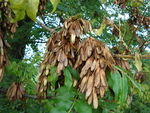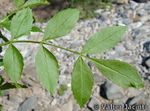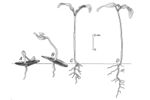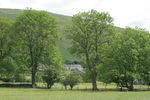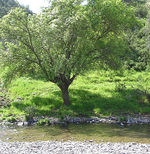Ash tree
| Ash tree |
|---|
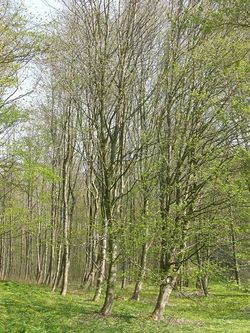
|
| Scientific Classification |
|
| Species |
|
| Ash trees can grow to be very tall; this one stands out among its surroundings. |
Ash trees are any of the species of trees belonging to the taxonomic genus Fraxinus. It is a deciduous perennial plant that is commonly found all across Europe and parts of North America. For many centuries, the ash tree has played an important role in the progress of mankind. The wood of the ash tree is very hard and has been used for purposes such as furniture, medicine, sports equipment, tools, and other items. [3] The ash tree has also plays an important role in many European traditions, cultures, and mythologies. [4]
Body Design
Ash trees are very easy to identify because they have very distinct characteristics, especially their leaves, branches, and bark. The branches of an ash tree are arranged in an opposite pattern, meaning that, unlike most trees that have alternating branches, its branches occur in pairs. Two branches branch off of the main stem, one on each side, opposite of each other.
Similarly, the buds and leaf scars on these branches and twigs also occur in an opposite pattern. [5] After growing for about thirty years, the ash tree begins to flower and produce seeds. The ash tree flowers in April and May, but has black buds which group in pairs during the winter. As spring arrives, the seeds fall and can be carried off by the wind. [6] [7] Normally, small purple flowers can be seen clustered in male and female clumps along the branches of the tree as well. However, different species of ash trees have different types of male and female flowers. Some trees rotate year after year with one year only producing female seeds, called keys, while the next year only producing male seeds. Other types though, will produce both, but on separate branches. Most commonly however, there are just male and female clumps. [8] To help prevent self-fertilization, the male flowers do not pollinate until the female flowers of the same tree are no longer receptive. Also around this time of year, the fruit of the ash tree can be seen. The fruit is winged and elongated, hanging in green clusters that eventually become brown. [9]
As for the ash tree’s leaves, they arrive after the buds do and are pinnately compound. Compound leaves are ones that have two or more individual leaves branching off of one main stem. Depending on the species, ash trees have five to eleven leaflets per leaf. The edges of these leaves are also reasonably toothed. On the leaf scars, there are many small dots in a crescent pattern. [10] [11] Most varieties of ash trees have leaves that tend to be green in the summer, but change to yellow or purple in the fall. Out of all the varieties of ash tree, the white ash has the largest leaves. [12]
As for the bark of the ash tree, it has deep cracks and is a grayish-brown color. However, on the parts of the tree that are younger, like new twigs, the bark is more smooth an of a pale greenish-gray color. [13] Certain types of ash trees have slightly different appearances. For instance, the black ash has thin, scaly, and an ashy-gray colored bark, whereas the white and green ash trees have thick, diamond-patterned bark. Another type of ash tree is the rare blue ash, which can be recognized by its unique four-sided stems; most other ash trees have round stems. [14]
Healthy ash trees tend to grow rapidly, reaching fifty to eighty feet tall in their lifetime, and about fifty to ninety feet wide in total diameter. Because ash trees can grow to be so large, they need a lot of space, especially for their [[[roots]]. Many ash trees struggle to survive if they are surrounded by other trees because their roots need a lot of space to expand and grow. [15] However, once they reach to be around fifty years old, they stop growing. [16]
Life Cycle
The ash tree is a perennial plant meaning it continues to grow year after year. After about thirty years, the ash tree begins to flower and produce seeds in May. The ash tree has elongated, winged seeds that contain one seed per nutlet. These seeds are called keys. The female flowers produce seeds that ripen by late summer and turn a pale green. By late autumn, these seeds dry to a brown color and are distributed by the wind to eventually germinate on the ground where they land. [17] After about 100 years, the ash tree reaches full maturity, but it is uncommon for an ash tree to live much longer that 250 years. [18]
Ecology
The ash tree is native to Northern Europe and can also be found in parts of America. These are primary conditions for the ash tree to live in because it grows best in places with moderately damp soil that is not too acidic. The ash tree tends to grow in areas where there is plenty of space, not only because its roots need room, but also because it needs an abundance of light, which, if surrounded by other trees, it may not be able to receive. The ash tree also flourishes in areas of limestone. The one problem with this however, is that the beech tree also likes these areas and can sometimes dominate over the ash trees. This being the case, many ash woodlands are found along the periphery of the beech tree’s habitat. [19] The ash tree also tends to grow along riverbanks, valley woodlands, and meadows. [20]
Along with the beech tree, some other threats to the ash tree include emerald ash borers, anthracnose, ash yellows, verticullium wilt, banded ash clearwigs, ash flowergall mites, ash rust, powdery mildew, ash anthracnose, cankers, butt rots, and root rots. Emerald ash borers are small invasive beetles that attack the ash tree’s nutrient carrying vessels, causing it to slowly die from the top down. They can be identified by their S-shaped galleries they make on the underside of the tree’s bark and their D-shaped exit holes. Anthracnose is a disease that causes widespread shoot dieback, twig death, and defoliation. It can be identified by brown areas on the tree’s leaves, purplish-brown coloring along the veins of the leaves, and canker on the trunk and main branches of the ash tree. Ash yellows is another disease which targets mostly the white and green ashes, and which cause a loss in vigor in a tree over a period of many years. This can be spotted by the ash tree’s leaves beginning to turn yellow and losing its leaves early. Cankers may also begin to form on the branches and trunk, resulting in dieback. Verticullium wilt is another infection that causes dieback and cankers. [21]
Unlike most other types of trees, the ash does not support many invertebrates. This includes things like slugs, worms, snails, and other legless insects. This being the case, the range of bird species is few, but it does serve as a home to some robins, blackbirds, chaffinches, and wrens. [22]
The History and Folklore Behind Ash Trees
In many European cultures, the ash tree plays a prominent role. The etymology of ash is believed to come from the Anglo-Saxon word aesc, which means spear. [23] For hundreds of years, the ash tree was considered sacred and the founder of mankind. Many scholars are puzzled as to why the ash tree was considered so sacrosanct to many cultures, but some think it has something to do with the sugary honey that can be secreted from certain ash trees. Up until the beginning of this century, this honey-like syrup was harvested and was referred to as manna. [24] In English folklore, the ash tree was used to determine what the weather was to be like. At one time, it was thought that the opening of the ash tree’s buds, in comparison to the opening of the oak tree’s buds, would determine how wet or dry the season would be. The summer would be dry if the oak buds appeared to open first, but would be wet if the ash buds opened first. An old rhyme was created to help remember this:
Oak before ash, in for a splash
Ash before oak, in for a soak. [25]
Video
This is a video explaining how to identify an ash tree, EAB, and the signs of infestation.
Gallery
References
- ↑ Author Unknown. Plants Profile United-States-Department-of-Agriculture. Web. Date-of-last-access 26 May 2013.
- ↑ Catologue of Life. Fraxinus Encyclopedia-of-Life. Web. Date-of- last-update April 2013.
- ↑ Smith, Rebekah. Uses-of-Ash-Trees eHow.com. Web. Date-of-last-access 27 May 2013.
- ↑ ”Azara”. The-Common-Ash-Tree H2G2. Web. March 12, 2007 date of last-update or access.
- ↑ Pelliteri, Phil. What-Does-An-Ash-Tree-Look-Like? Wisconsin’s-Emerald-Ash-Borer-Information-Source. Web. Date-of- last-access May 18, 2013.
- ↑ ”Azara”. The-Common-Ash-Tree H2G2. Web. March 12, 2007 date of last-update or access.
- ↑ Author Unknown. Ash-Fact-File ARKive. Web. Date-of- last- access May 18, 2013.
- ↑ ”Azara”. The-Common-Ash-Tree H2G2. Web. March 12, 2007 date of last-update or access.
- ↑ Author Unknown. Ash-Fact-File ARKive. Web. Date-of-last-access May 18, 2013.
- ↑ Pelliteri, Phil. What-Does-An-Ash-Tree-Look-Like? Wisconsin’s-Emerald-Ash-Borer-Information-Source. Web. Unknown Date-of-publication or last-update or access.
- ↑ ”Azara”. The-Common-Ash-Tree H2G2. Web. March 12, 2007 date of last-update or access.
- ↑ Cartmell, Paul. The-Lifespan-of-Ash-Trees eHow. Web. January 9, 2013 last-update or access .
- ↑ ”Azara”. The-Common-Ash-Tree H2G2. Web. March 12, 2007 date of last-update.
- ↑ Pelliteri, Phil. What-Does-An-Ash-Tree-Look-Like? Wisconsin’s-Emerald-Ash-Borer-Information-Source. Web. May 18, 2013 Date-of- last-update or access.
- ↑ Cartmell, Paul. The-Lifespan-of-Ash-Trees eHow. Web. January 9, 2013 last-update or access .
- ↑ Author Unknown. Ash-Fact-File ARKive. Web. Date-of- last- access May 18, 2013.
- ↑ Norton, Joan. The-Life-Cycle-of-the-Ash-Tree Garden-Guides.com. Web. Date-of-last-update 2010.
- ↑ Cartmell, Paul. The-Lifespan-of-Ash-Trees eHow. Web. January 9, 2013 last-update or access .
- ↑ ”Azara”. The-Common-Ash-Tree H2G2. Web. March 12, 2007 date of last-update or access.
- ↑ Author Unknown. Ash-Fact-File ARKive. Web. Date-of-last-access May 18, 2013.
- ↑ Authorlastname, Firstname. Ash-Tree Savatree. Web. Date-of- last- access May 19, 2013.
- ↑ ”Azara”. The-Common-Ash-Tree H2G2. Web. March 12, 2007 date of last-update or access.
- ↑ ”Azara”. The-Common-Ash-Tree H2G2. Web. March 12, 2007 date of last-update or access.
- ↑ Dumont, Darl. The-Ash-Tree-in-Ind0-European-Culture "Musaios. Web. Date-of-publication summer 1992.
- ↑ ”Azara”. The-Common-Ash-Tree H2G2. Web. March 12, 2007 date of last-update or access.

